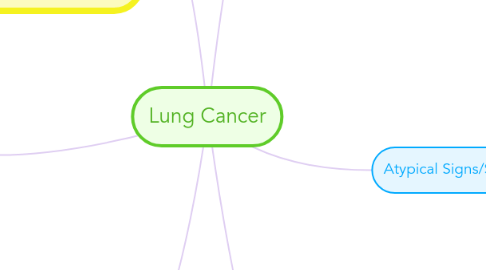
1. Tobacco Use
1.1. Directly related to other cancers such as: mouth, lip, larynx/pharynx, esophagus, and many others
1.2. Smoking causes more deaths then vascular diseases
1.3. Education on smoking cessation is imperative with each patient who smokes. We must also provide numerous resources to help our patients quit this addiction. Community resources, nicotine patches & gum, and support groups are essential
2. Diagnosis
2.1. Usually symptoms of lung cancer don’t appear until the disease is already at an advanced, non-curable stage. Even if lung cancer does cause symptoms, many people may mistake them for other problems, such as an infection or long-term effects from smoking. This may delay the diagnosis.
2.2. Chest X-Ray or CT
2.3. Exposure to such radiation can increase the risks; however, screening high risk populations such as individuals older than 55 with a smoking hx can possibly detect early onset of cancer and prevent death
3. Signs/Symptoms
3.1. Weight loss and loss of appetite
3.2. A cough that does not go away or gets worse
3.3. Shortness of breath/New onset of wheezing
3.4. Reoccuring infections such as bronchitis and pneumonia
3.5. Hoarseness
3.6. Coughing up blood or rust-colored sputum (spit or phlegm)
4. Causative Factors/Risk Factors
4.1. Lifestyle implications such as tobacco smoking and second hand smoking exposure
4.1.1. Lung cancer is the leading cause of cancer death among both men and women; about 1 out of 4 cancer deaths are from lung cancer.
4.2. Environmental exposure of carcinogens found within manufacturing areas such as fumes and small particulates that are inhaled for extended periods of time
4.3. Radiation and exposure to Radon, a naturally occurring gas
5. Atypical Signs/Symtoms
5.1. Horner syndrome
5.1.1. Cancers of the top part of the lungs (sometimes called Pancoast tumors) can affect certain nerves to the eye and part of the face, causing a group of symptoms called Horner syndrome: -Drooping or weakness of one eyelid -Unequal Pupils -Reduced or absent sweating on the same side of the face - severe shoulder pain.
5.2. Superior vena cava syndrome
5.2.1. The superior vena cava is a large vein that carries blood from the head and arms back to the heart. It passes next to the upper part of the right lung and the lymph nodes inside the chest. Tumors in this area can press on the SVC, which can cause the blood to back up in the veins. Symptoms include: swelling in the face, neck, arms, and upper chest, headaches, dizziness, and a change in consciousness.
5.3. Paraneoplastic syndromes
5.3.1. Some lung cancers can make hormone-like substances that enter the bloodstream and cause problems with distant tissues and organs, even though the cancer has not spread to those tissues or organs.
